
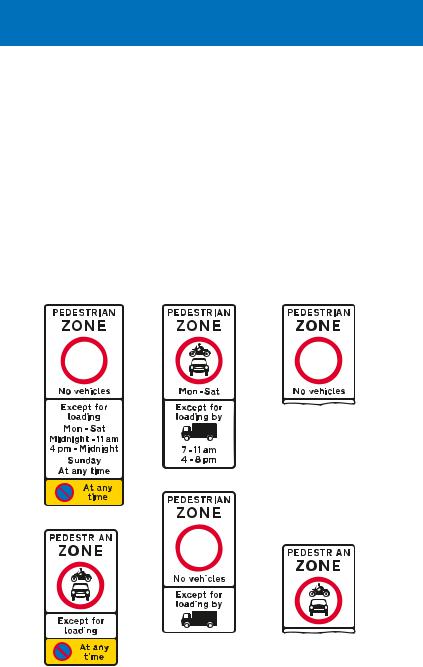
pedestrian zone signs
Pedestrian zone signs
Areas such as shopping streets may be signed as “pedestrian zones”. Depending on the extent of the vehicle entry restrictions, such areas may be paved without the usual separation between footway and carriageway and may not have yellow lines and kerb markings to indicate waiting and loading restrictions. Instead restrictions are detailed on zone entry signs and repeater plates. The entry signs may indicate that buses, taxis, disabled badge holders or permit holders may enter the zone. Various examples of zone entry signs are shown below.
All vehicles, including ridden pedal cycles, prohibited. (The hours during which a part-time zone operates will be shown in this panel and exemptions in a lower panel)
|
|
|
|
|
|
|
|
|
|
|
|
|
|
|
|
|
|
|
|
|
|
|
|
|
|
|
|
|
|
|
|
|
|
|
|
|
|
|
|
|
|
|
|
|
|
|
|
|
|
|
|
|
|
|
|
|
|
|
|
|
|
|
|
|
|
|
|
|
|
|
|
|
|
Signs without yellow |
Ridden pedal cycles |
||||
|
|
|
|
||||||
|
|
|
|
||||||
|
|
|
|
panels are used |
permitted within the |
||||
|
|
|
|
||||||
|
|
|
|
||||||
The yellow panels |
where access may |
zone. (The hours |
|||||||
be more restrictive |
during which a |
||||||||
indicate that there |
|||||||||
and where waiting |
part-time zone |
||||||||
are waiting |
|||||||||
restrictions, if any, |
operates will be |
||||||||
restrictions within |
|||||||||
are indicated by |
shown in this panel |
||||||||
the zone |
|||||||||
yellow lines within |
and exemptions in a |
||||||||
|
|
|
|
||||||
|
|
|
|
the zone |
lower panel) |
||||
37
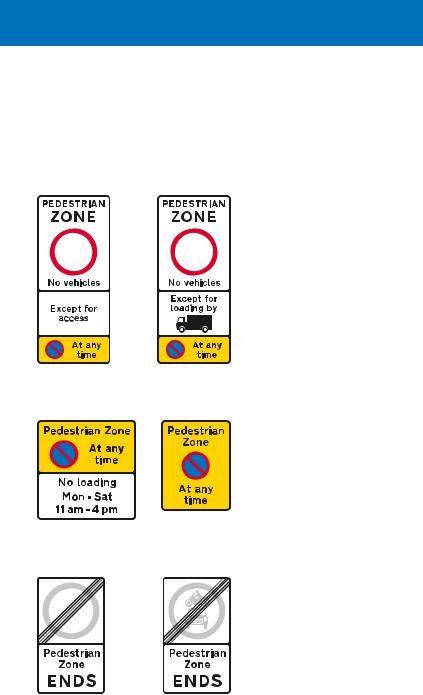
Where different entry restrictions apply at different times of the day, and these restrictions are too complicated to show on the zone entry sign, a sign that can change its display (a variable message sign) may be used. It is therefore important always to check the restrictions in force before entering the zone.
Example of a variable message zone entry sign showing alternative displays for the middle panel (exemptions)
Two examples of waiting restriction repeater signs within the zone. (There may be no yellow lines or kerb markings)
At the end of the zone, a “zone ends” sign will be displayed. The prohibitory roundel in the upper panel will be a grey version of the roundel shown on the entry sign
38
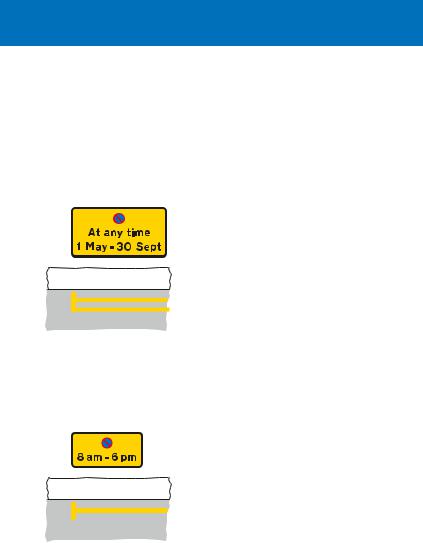
on-street parking control signs and road markings
On street parking control signs and road markings
Waiting restrictions
Waiting restrictions are indicated by both signs and road markings. The restrictions usually apply
to the whole of the highway, including verges and footways. Drivers may stop to pick up or set down passengers and, where not prohibited, to load and unload. Disabled blue badge holders can usually park for up to three hours or, in Scotland, without a time limit (see The Blue Badge Scheme – Explanatory Book published by the Department for Transport; visit www.dft.gov.uk).
Yellow lines along the edge of the carriageway, parallel to the kerb, indicate that restrictions are in force. In environmentally sensitive areas, a pale shade of yellow may be used and the width of the lines may be reduced. Except in controlled parking zones (see page 52), small
yellow plates are normally erected adjacent to the carriageway to give details of the times of operation of the restrictions. Where the yellow plate does not indicate the days of the week, the restrictions apply at the same times every day, including Sunday. If a bank holiday falls on a day when the restrictions are in operation, the restrictions apply in the normal way unless the plate states that they do not. Special restrictions may apply on days when a large event is being held at a nearby stadium or arena; these will also be shown on the plates.
39
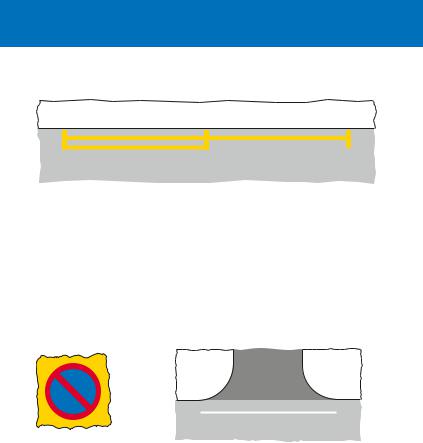
A double yellow line means no waiting at any time. The accompanying yellow plate, “no waiting at any time”, is gradually being phased out. Where the “at any time” restriction applies for only part of the year (e.g. during the summer months at a holiday resort) and is for at least four consecutive months, double yellow lines are used with plates giving the dates that the restrictions apply. Waiting restrictions that apply for a shorter period or for only part of the day or week are indicated by a single yellow line.
This "no waiting" |
|
|
|
|
|
|
|
|
|
|
|
sign is used on |
Length of road to be kept clear of stationary |
||||
portable signs to |
vehicles, at entrances to off-street premises |
||||
mark temporary |
or where the kerb is dropped to provide a |
||||
waiting restrictions |
convenient crossing place for pedestrians |
||||
Loading restrictions
Where loading restrictions apply in addition to waiting restrictions (“loading” means both loading and unloading), these are indicated by both yellow kerb marks and white plates. These plates may be combined with the yellow “no waiting” plates. As the marks are placed intermittently along the kerb, a white plate is normally erected at the first mark (where the loading restriction begins) and may include an arrow indicating the direction along the road in which the loading restriction applies. Where a white plate does not indicate the days of the week, the restrictions apply at the same times every day, including Sunday. If a bank holiday falls on a day when the restrictions are in operation, the restrictions apply in the normal way unless the plate states that they do not.
40
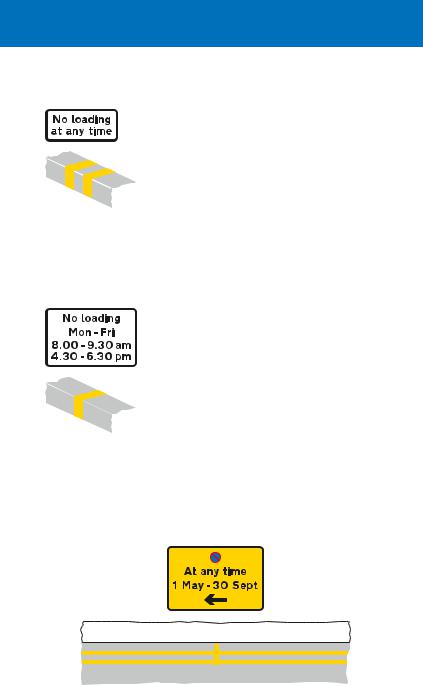
on-street parking control signs and road markings
Loading prohibited 24 hours a day, 7 days a week, for at least 4 consecutive months. The plate should include dates if the restriction does not apply throughout the year
Loading prohibited between times shown on the sign
Special restrictions may apply on days when a large event is being held at a nearby stadium or arena; these will also be shown on the plates. Disabled blue
badge holders may not park when loading restrictions are in force.
A double kerb mark means no loading at any time and is always supplemented by a “no loading at any time” plate. Where the “at any time” restriction applies for only part of the year (e.g. during the summer months at a holiday resort) and is for at least four consecutive months, double kerb marks are used with plates giving the dates that the restrictions apply. Loading restrictions that apply for a shorter period or for only part of the day or week are indicated by a single kerb mark.
Examples of waiting and loading restriction signs and markings
No waiting at any time during the summer months in the direction of the arrow. No waiting at any time throughout the year in the opposite direction (no yellow plate required). The changeover point is indicated in the carriageway by the transverse mark on the double yellow lines
41
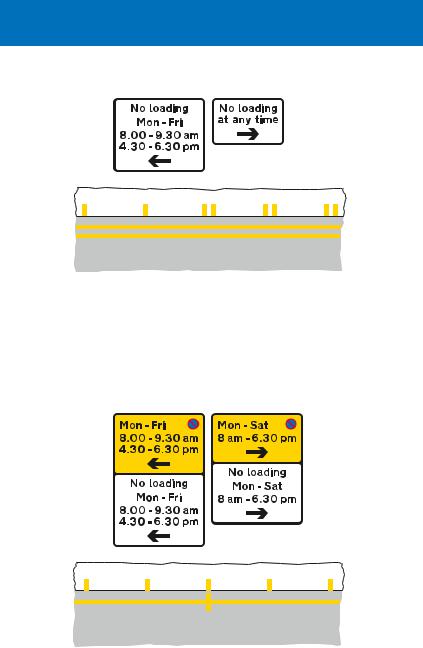
No waiting at any time throughout the year in both directions. No loading to the left during the days and times shown. No loading at any time throughout the year in the opposite direction. The white plates with arrows are placed at the changeover point. There is no transverse mark on the double yellow line because the waiting restrictions do not change
No waiting and loading to the left during morning and evening peak hours on the days shown. No waiting and loading to the right from morning to evening on the days shown. The changeover point for the waiting restrictions is shown by the transverse mark on the single yellow line. The times shown for peak periods and day-time restrictions may vary
42
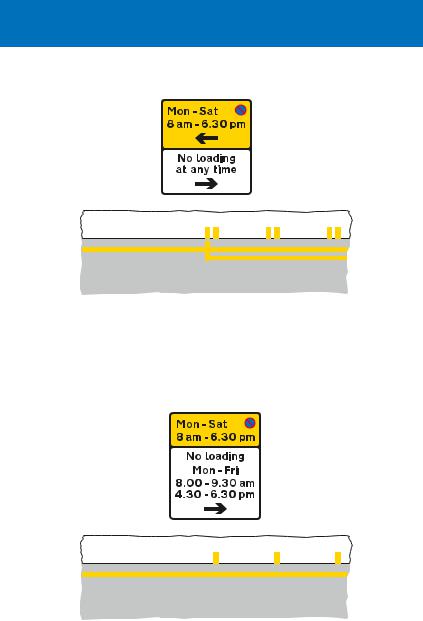
on-street parking control signs and road markings
No waiting to the left during the days and times indicated. Loading is permitted at all times in this direction. Waiting and loading prohibited to the right at all times throughout the year
The prohibition of waiting shown on the upper yellow panel on the plate applies in both directions. The prohibition of loading shown on the lower white panel of the plate applies only in the direction of the arrow. In the other direction, loading is permitted at all times. The arrow applies only to the white panel on which it is placed, not to the whole plate. There is no transverse mark on the single yellow line because the waiting restrictions do not change
43
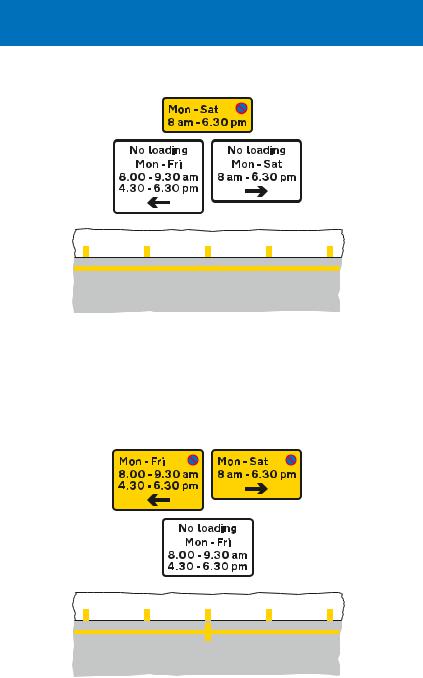
The prohibition of waiting shown on the yellow plate applies in both directions. No loading to the left during morning and evening peak hours on the days shown. No loading to the right from morning to evening on the days shown. The white plates with arrows are placed at the changeover point. There is no transverse mark on the single yellow line because the waiting restrictions do not change. The times shown for peak periods and day-time restrictions may vary
No waiting to the left during morning and evening peak hours. No waiting to the right from morning to evening on the days shown. No loading during morning and evening peak hours in both directions. The changeover point for the waiting restrictions is shown by the transverse mark on the
single yellow line
44
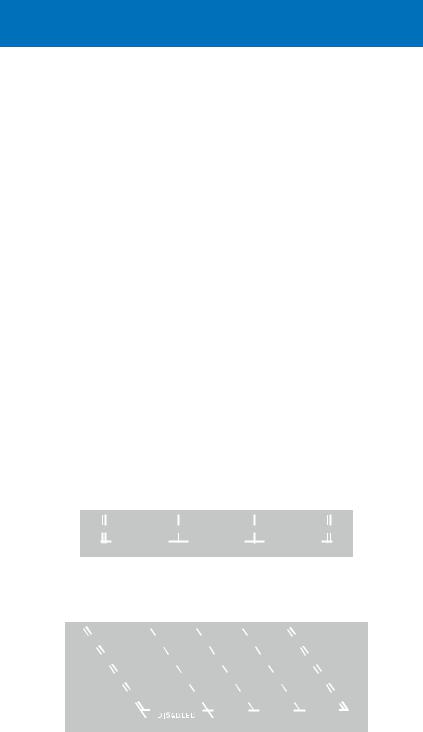
on-street parking control signs and road markings
On street parking places
On street parking places may be designated for a particular class of vehicle (e.g. solo motorcycles) or for a particular user (e.g. permit holders or disabled badge holders). Parking may be free or paid for (e.g. “pay and display” or parking meters). There may be a time limit on the period of stay and a minimum time before returning to a particular parking place. Some bays may be designated for use by more than one class of vehicle or user, either at the same time or at different times during the day.
Bays are generally marked in white, and are either continuous or divided into individual spaces. They may include words on the carriageway indicating the use of the bay (e.g. DISABLED). Plates are normally erected adjacent to the carriageway to give details of the parking controls. Where a plate does not indicate the days of the week, the restrictions apply at the same times on every day, including Sunday. Where the time of day is not shown, the controls apply for 24 hours. If a bank holiday falls on a day when the controls are in operation, the controls apply in the normal way unless the plate states that they do not. Special controls may apply on days when a large event is being held at a nearby stadium or arena; these will also be shown on the plates.
Edge of carriageway
Parking bay with individual spaces (parallel to the kerb)
Edge of carriageway
Parking bay with individual spaces (echelon)
45
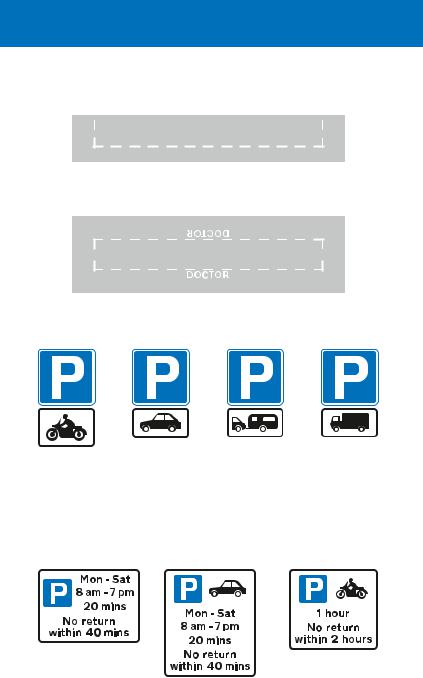
Edge of carriageway
Continuous parking bay adjacent to the kerb (words may be added outside the bay to describe the type of parking)
Continuous parking bay in the centre of the carriageway (the words are omitted where there is no restriction on the type of user)
Solo |
Motor cars |
Car and |
Goods |
|
caravan, or |
vehicles |
|
motorcycles |
|
motor caravan |
|
The above signs indicate free on-street parking places reserved at all times, with no time limit, for particular classes of vehicles. Other signs may indicate more specific parking controls.
Free parking for all vehicles from Monday to Saturday between 8 am and 7 pm, with a 20-minute time limit (no limit outside those times)
Free parking for motor cars only, from Monday to Saturday between
8 am and 7 pm, with a
20-minute time limit
Free parking for solo motorcycles only, with a one-hour limit at all times
46
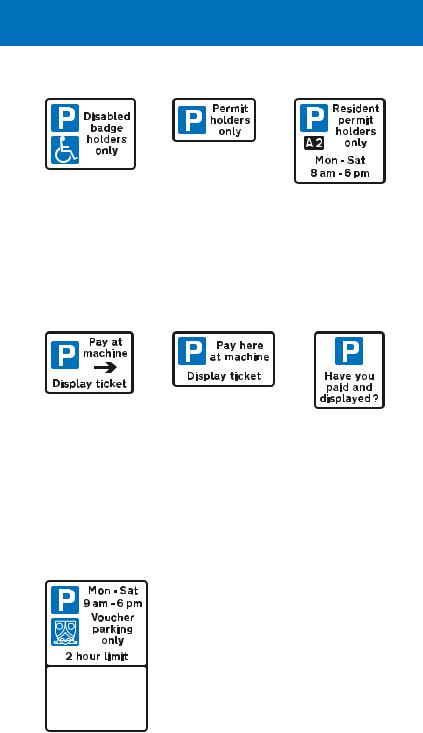
on-street parking control signs and road markings
Parking for disabled badge holders only, at all times. Older signs may still show the orange badge symbol; these should be replaced by the end of 2009
On-street pay and display parking (the arrow points towards the ticket machine). Days of the week and time periods may be added to indicate when parking must be paid for
Parking for permit holders only, at all times
Location of ticket machine for on-street pay and display parking
Parking for holders of permit “A2” only, from Monday to Saturday between 8 am and 6 pm
Reminder to pay and display at on-street parking place
Pre-paid voucher parking only, from Monday to Saturday between 9 am and 6 pm, with a two-hour time limit (lower panel may give details of voucher)
47
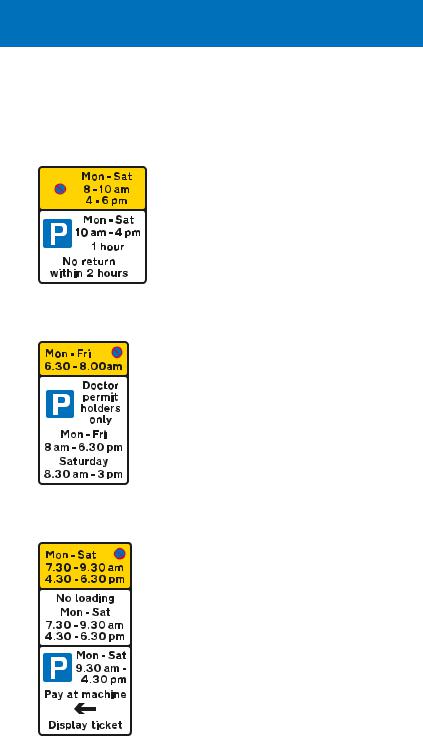
Where parking place controls do not operate at all times, any vehicle may park in the bay without payment or time limit unless other restrictions are indicated on the signs.
The upper panel indicates that waiting is prohibited during the morning and evening peak hours (a single yellow line will run through the bay). The lower panel indicates time-limited parking on Monday to Saturday between 10 am and 4 pm. Between 6 pm and 8 am the next day, and all day Sunday, there are no restrictions on parking
This sign indicates a parking place provided for doctors during the day-time, with a prohibition of waiting between 6.30 am and 8 am (a single yellow line will run through the
bay). These restrictions apply from Monday to Friday, with the bay also reserved for doctors on Saturday between 8.30 am and 3 pm
The top panel indicates that waiting is prohibited during the morning and evening peak hours (a single yellow line will run through the bay). The middle panel indicates that loading and unloading are also prohibited during the peak hours (there will be yellow kerb marks alongside the bay). The bottom panel indicates that the bay is used for pay and display parking on Monday to Saturday between 9.30 am and 4.30 pm. Between 6.30 pm and 7.30 am the next day, and
all day Sunday, there are no restrictions on parking or loading
48
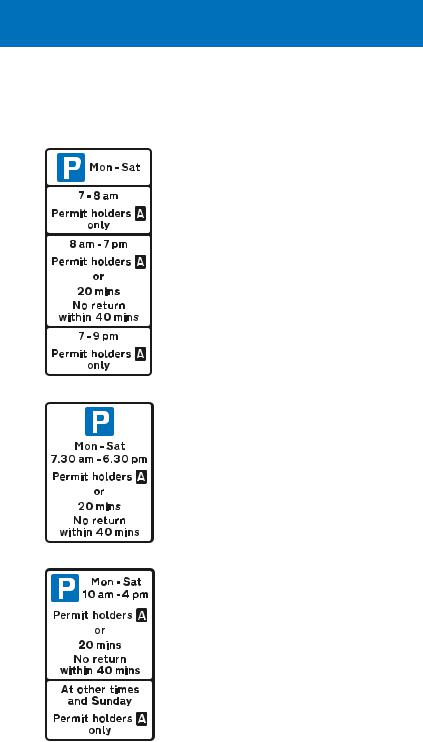
on-street parking control signs and road markings
Parking bays may be reserved for more than one type of user – at the same time, at different times, or a combination of both.
The top panel indicates that the parking controls apply from Monday to Saturday. Between 7 am and 8 am, and between 7 pm and 9 pm, the parking bay may be used only by permit holders. Between 8 am and 7 pm, the bay may be used by permit holders with no time limit, or by any other vehicle with a 20-minute time limit. At all other times and on Sunday the bay may be used by any vehicle without any time limit
The parking controls apply from Monday to Saturday between 7.30 am and 6.30 pm. During these times the bay may be used by permit holders, with no time limit, or by any other vehicle with a 20-minute time limit
The parking bay is reserved for permit holders, without time limit, at all times. Other vehicles may also use the bay,
but only from Monday to Saturday between 10 am and 4 pm, with a 20-minute time limit
49
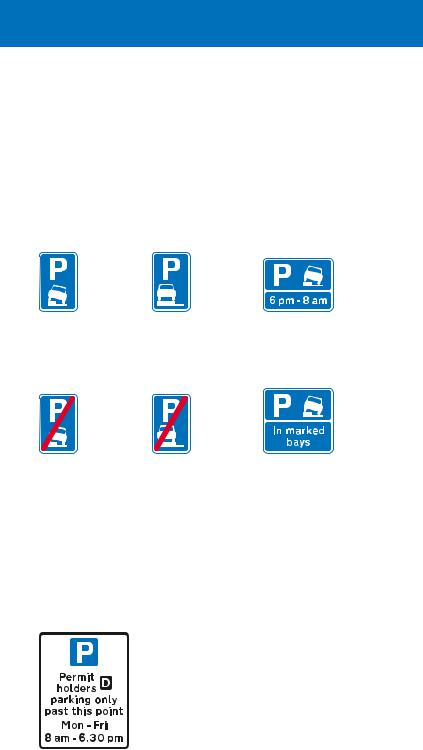
Although vehicles should not generally be parked on verges and footways (it is unlawful in London and some other cities), this may be allowed on certain narrow streets where parked vehicles would not obstruct pedestrians. There are special signs to indicate footway parking. There may also be white bays indicating where parking is permitted. Where there are controls applying to the parking place, such as pay and display, these should be indicated by separate signs.
Vehicles may be |
Vehicles may be |
Vehicles may be parked |
parked partially |
parked wholly |
partially on the verge or |
on the verge or |
on the verge or |
footway during the times |
footway |
footway |
shown |
End of verge or footway parking |
Vehicles may be parked |
|
partially on the footway |
|
in marked bays only |
Some residential streets, particularly culs-de-sac, which are reserved for permit holder parking only may not have any signs or bay markings within them, except possibly for a few repeater plates. A sign at the entrance to the street will indicate that parking is for permit holders only.
Parking for permit holders only in the street or streets beyond this sign, during the times shown
50
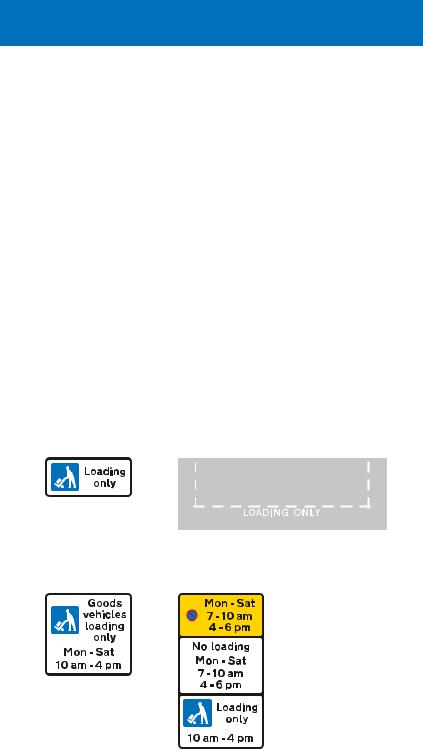
on-street parking control signs and road markings
Loading bays and loading areas
Special loading bays may be provided along with parking bays, or in areas where waiting and loading are otherwise prohibited. The bays may be reserved for use by goods vehicles (where indicated on signs) or may be used by all vehicles, e.g. outside shops where heavy purchases have to be carried to a car. However, these bays should not be used prior to making the purchase, but only for collection of pre-paid items when they are too large or heavy to carry to where the car is parked. Once loading is complete, the vehicle must leave the bay. Some loading bays may be used for other purposes at different times of the day. For example, the bay may be reserved for blue badge holders during the day and for loading during early morning and late afternoon. In such cases the bay will not be marked “LOADING ONLY”; it is therefore important to read the upright signs to see who can use the bay at certain times of day. There may be times, such as morning and evening peak periods, when loading is not permitted. In such cases there will be a single yellow line running through the bay and single “no loading” marks on the kerb.
Edge of carriageway
Bay reserved for loading and unloading by all vehicles at all times
Bay reserved for loading and unloading by goods vehicles only during the times shown
Loading bay (conditions of use shown on upright sign)
Waiting and loading are prohibited from Monday to Saturday during the times shown in the top and middle panels. The bay may be used for loading only during the times shown in the bottom panel, including Sunday
51
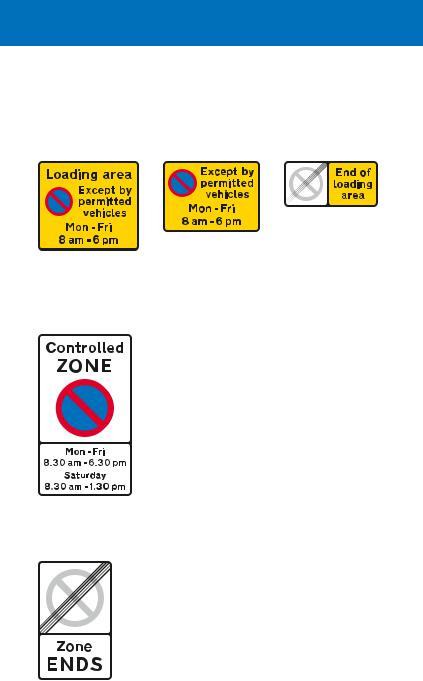
Off highway areas may be designated “loading areas” where waiting is restricted except by permitted vehicles. Signs are used without road markings to indicate this.
End of loading area
Repeater sign within Entrance to a loading area
a loading area
Controlled parking zones
Entrance to a controlled parking zone
End of controlled or voucher parking zone
Some areas are designated as controlled parking zones. The entry sign indicates the times when waiting is prohibited. The yellow lines within the zone do not normally have yellow plates indicating the times of the prohibition unless the times are different from those shown on the entry sign. It is therefore important to note the times shown when entering the zone. If there is no lower panel showing days and times, the zone operates at all times. If loading is prohibited at the same time as the waiting prohibition, the entry sign should include the words “No loading” at the bottom of the upper panel. The zone is likely to include parking places and loading bays. Some parking places may be for permit holders only, others for general use. The times when these operate should be shown on the signs at the bays; these times may not be the same as those shown on the zone entry sign. Where the majority of on street parking within the zone is pay and display, the heading on the entry sign may say “Pay and Display ZONE” instead of “Controlled ZONE”.
52
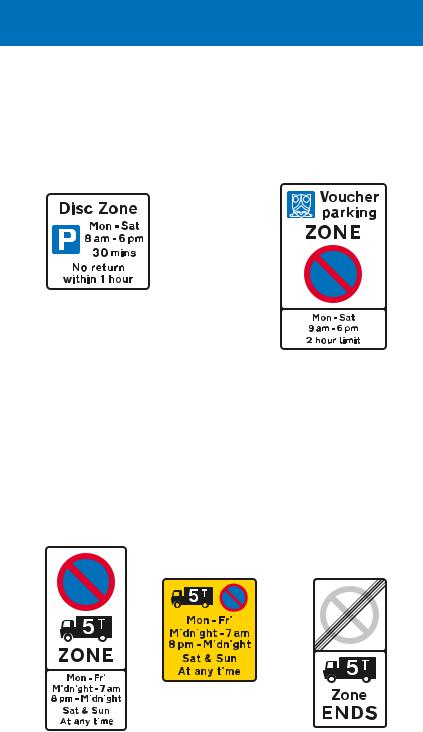
on-street parking control signs and road markings
Other headings might be “Meter ZONE” where there are parking meters, or “Disc ZONE” where a parking disc showing the time of arrival has to be displayed on the vehicle when parking. The entry sign to a pre paid voucher parking zone includes the voucher logo.
Sign at a parking bay within a disc |
|
zone. Free parking for all vehicles, |
|
with a 30-minute time limit from |
|
Monday to Saturday between 8 am |
|
and 6 pm. A parking disc indicating |
|
the time of arrival at the parking bay |
Entrance to a voucher |
must be displayed in the vehicle |
parking zone |
In some areas, local authorities operate special goods vehicle waiting restrictions. Usually these apply to goods vehicles of over 5 or 7.5 tonnes maximum gross weight. Where the same restrictions apply throughout a zone, usually overnight, the times are indicated on a zone entry sign. Within the zone there are no yellow lines (unless there are other waiting restrictions applying to all vehicles), but there should be repeater signs on each side of every street as a reminder. There are equivalent signs for buses
with the bus symbol, and signs that apply to both goods vehicles and buses.
|
|
|
|
|
|
|
|
|
|
|
|
|
|
|
|
|
|
|
|
|
|
|
|
|
|
|
|
|
|
|
|
|
|
|
|
|
|
|
|
|
|
|
|
|
|
|
|
|
|
|
|
|
|
|
|
|
|
|
|
|
|
|
|
|
|
|
|
|
|
|
|
|
|
|
|
|
|
|
|
|
|
|
|
|
|
|
|
|
Repeater sign indicating |
|
|||||
|
|
|
|
|
|
||||||
|
|
|
|
|
|
||||||
|
|
|
|
|
|
||||||
|
|
|
|
|
|
||||||
|
|
|
|
|
|
||||||
|
|
|
|
|
the times when waiting by |
|
|||||
|
|
|
|
|
goods vehicles over the |
|
|||||
|
|
|
|
|
|
||||||
|
|
|
|
|
maximum gross weight |
Zone exit |
|||||
Zone entry |
shown is prohibited |
||||||||||
53
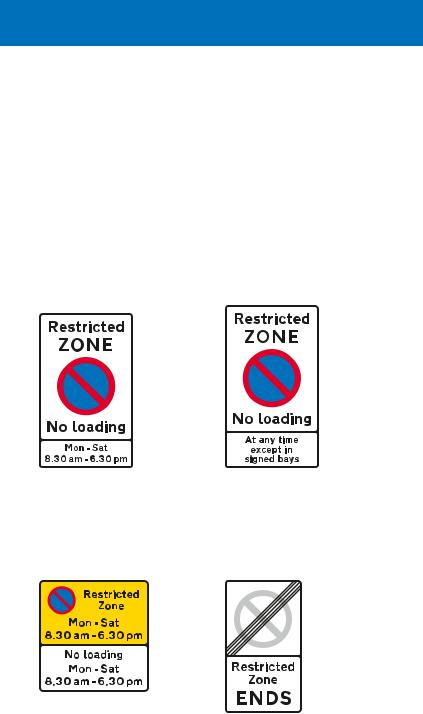
Restricted parking zones
In some environmentally sensitive areas, where waiting and loading restrictions are uniform, they may be indicated by upright repeater signs, but not yellow lines and kerb marks. These are known as restricted parking zones. The zone entry sign indicates the times when waiting and loading are prohibited. Where parking and loading are permitted, usually in signed bays, this should be indicated on the entry signs. The bays within the zone may be fully marked in the conventional manner or indicated by other means such as a change in surface materials. Upright signs will give details about the use of the bays.
Entrance to a restricted parking zone where both waiting and loading are prohibited during the times shown in the lower panel. The words “No loading” are omitted where loading is not prohibited
Entrance to a restricted parking zone where both waiting and loading are prohibited at all times, but where parking and loading bays have been provided. The words “No loading” are omitted where loading is not prohibited
Repeater sign within a restricted parking zone. The lower panel is omitted where loading is not prohibited
End of restricted parking zone
54
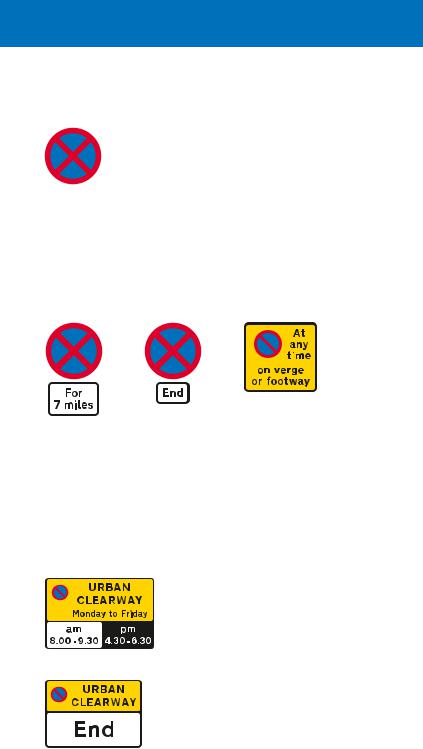
on-street parking control signs and road markings
Clearways
The red cross means no stopping, not even to pick up or set down passengers. The sign is used to indicate a 24-hour clearway (usually on a rural road) or may be incorporated into other signs with the words “No stopping” (e.g. the “no
stopping except local buses” sign at bus stops). On a 24-hour clearway, the prohibition of stopping applies only to the main carriageway. You may stop in a lay by unless there are signs to say otherwise. A 24-hour clearway does not have any special road markings, but there should be smaller repeater signs at approximately one mile intervals.
Start of 24-hour clearway (no stopping on main carriageway at any time for the distance shown)
|
|
|
|
This sign is used on a 24-hour |
|
End of |
clearway where waiting is |
|
24-hour |
prohibited on the verge or |
|
clearway |
footway in addition to the |
|
|
prohibition of stopping on the |
|
|
main carriageway. The words |
|
|
“on verge or footway” may be |
|
|
varied to “on verge” or “on |
|
|
footway”. Where the “no |
|
|
waiting” symbol is replaced by |
|
|
the red cross, stopping on the |
|
|
verge or footway is prohibited |
|
In built-up areas, urban clearways may be provided. During the times the urban clearway is in operation, stopping is not allowed on the carriageway or verges, except to pick up or set down passengers. There are no special road markings, but the signs are repeated throughout the length of the clearway
End of urban clearway
55
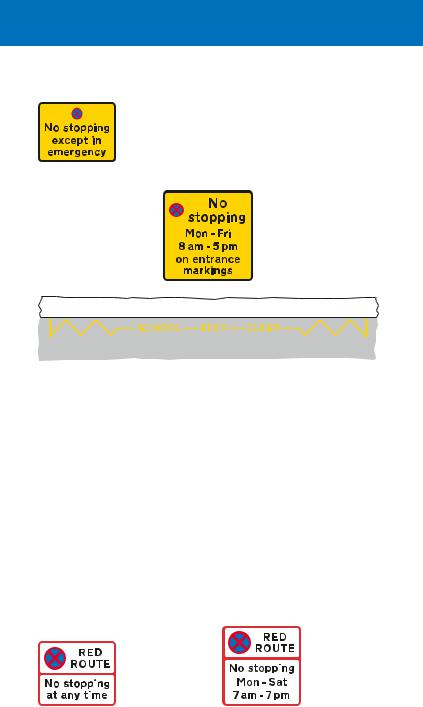
Stopping in lay-by not allowed, except in an emergency (similar to hard shoulders on a motorway). This may not apply to the whole lay-by. The length over which stopping is prohibited will be indicated by double yellow lines. These lay-bys usually have an emergency telephone
Yellow zig-zag markings outside schools, hospitals or fire, police or ambulance stations indicate the length of road where you should not stop, not even to pick up or set down children or other passengers. Where there is an upright sign, there is a mandatory prohibition of stopping during the times shown. These markings are provided outside schools to ensure that children can see and be seen clearly when crossing the road
Red routes
On red routes, yellow waiting restriction lines are replaced by red lines that mean no stopping for any purpose, not even to pick up or set down passengers, other than by a licensed taxi. A driver of a vehicle displaying a blue badge may stop to pick up or set down a disabled person, but must not park.
|
|
|
|
|
|
|
|
|
|
|
|
|
|
|
|
|
|
|
|
|
|
|
|
|
|
|
|
|
|
|
|
|
|
|
|
|
|
|
|
|
|
|
|
|
|
|
|
|
|
|
|
|
|
|
|
Double red lines mean |
Single red lines mean no stopping |
||||||
no stopping at any time |
during the days and times shown |
||||||
|
|
|
|
on the upright sign |
|||
56
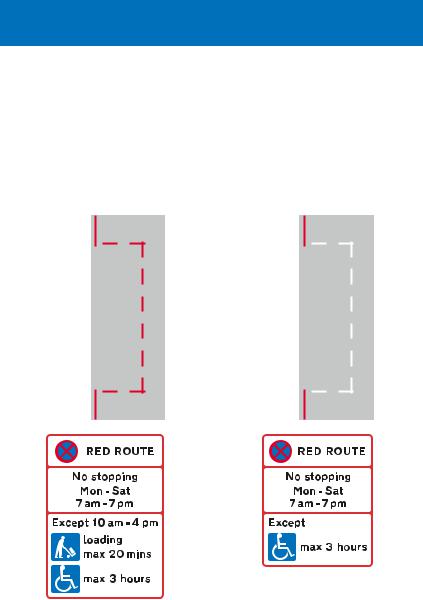
on-street parking control signs and road markings
The prohibition of stopping applies to the whole road, including the verge and footway, during the times shown on upright signs that face oncoming traffic. Special bays marked on
the carriageway may be provided for parking or loading; the conditions that apply to these will be indicated on upright signs that should also face oncoming traffic.
A bay marked with red broken lines means that it is available for use for only part of the time that the red route "no stopping" rule applies. The bay must not be used from Monday to Saturday between 7 am and 10 am nor between 4 pm and 7 pm. In this example, the bay may be used for loading/unloading (max stay 20 minutes) and by blue badge
holders (max stay 3 hours), during the times shown in the bottom panel
A bay marked with white broken lines means that it is available for use at all times that the red route "no stopping" rule applies. The upright sign shown in this example means that the bay is reserved for blue badge holders, with a maximum stay of 3 hours
57
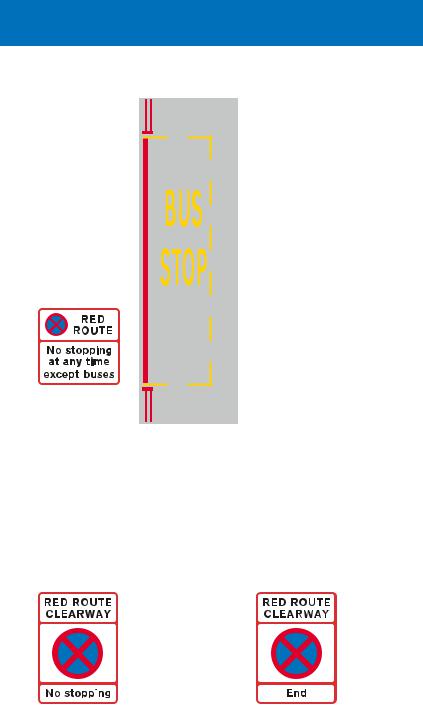
Licensed taxis may pick up or set down passengers at bus stops on a red route where there is a broad continuous yellow line at the edge of the carriageway, but not if the broad line is red. Drivers of vehicles
displaying a blue disabled badge are not permitted to stop for any purpose in a bus stop bay where there is either a broad yellow or broad red line
Some red routes have upright signs without any road markings. These are designated “RED ROUTE CLEARWAYS”, where stopping for any purpose is prohibited at all times, except in marked lay bys. Unlike the 24-hour clearway on rural roads, stopping on a red route clearway is prohibited on the verge and footway as well as on the main carriageway. There should be red lines at junctions to warn drivers entering the clearway from a side road.
|
|
|
Start of a red route clearway |
End of red route |
|
(also used as a repeater sign, |
clearway |
|
particularly after a road junction) |
|
|
58
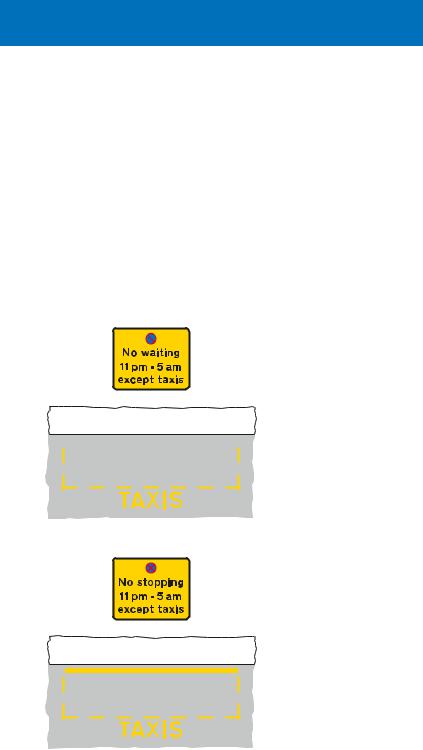
on-street parking control signs and road markings
Taxi ranks
Taxi ranks usually have yellow bays marked with the word “TAXIS”. Where the bay is used for other purposes (e.g. loading and unloading) at a different time of day, the bay will be white without any words. Either waiting or stopping will be prohibited within a taxi rank. Where stopping is prohibited, the bay includes a broad continuous yellow line at the edge of the carriageway. Where waiting is prohibited in taxi ranks, yellow “no waiting” lines are provided where waiting is also prohibited at other times, or where the bay marking is white because it has shared use. Yellow upright signs show the times when waiting or stopping is prohibited in the rank.
No waiting in taxi rank during the times shown
No stopping in taxi rank during the times shown. The bay includes a broad continuous line to indicate the prohibition of stopping
59
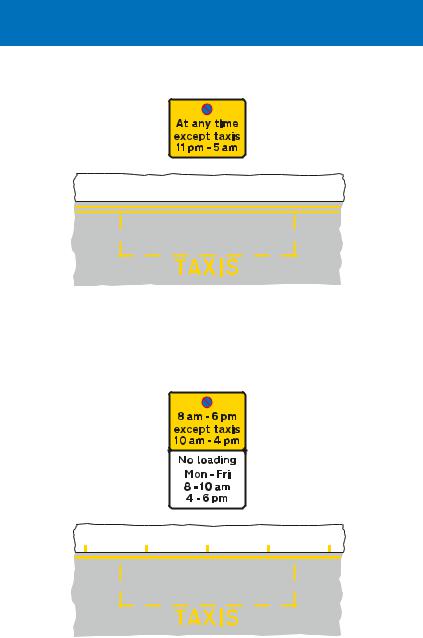
Waiting is prohibited at all times (indicated by double yellow lines). The taxi rank operates from 11 pm to 5 am every day
The taxi rank operates every day between 10 am and 4 pm. Waiting is otherwise prohibited from 8 am to 6 pm every day, and loading is prohibited during the morning and evening peak hours from Monday to Friday
60
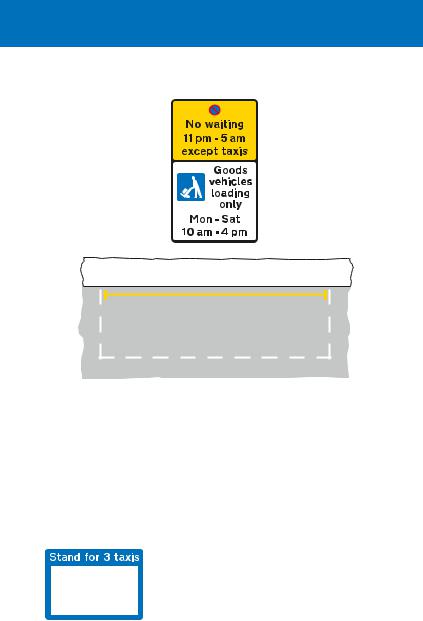
on-street parking control signs and road markings
The sign shows the times when the bay is used as a taxi rank (overnight) and when it is used for loading by goods vehicles (during the day from Monday to Saturday). At other times there are no restrictions on parking. The single yellow line is replaced by a broad yellow line if stopping by other vehicles is prohibited during the times the bay is used by taxis.
This will be indicated in the upper panel of the sign, where the “no waiting” symbol is replaced by the red cross and the words “No waiting” varied
to “No stopping”
Information boards may be provided at taxi ranks
61
